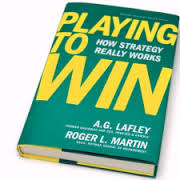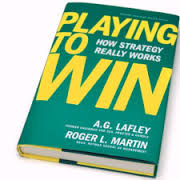A client of mine recently asked me if I had read Playing to Win – How Strategy Really Works by A.G. Lafley and Roger L. Martin. Lafley is the former Chairman and CEO of Procter & Gamble and Martin is the Dean of the Rotman School of Management at the University of Toronto. I always enjoy learning from other successful CEOs, and Proctor and Gamble has been a widely successful company building some of the best consumer brands in the world, so I purchased a copy of the book.
The book is based on experiences and lessons learned by Lafley to help create a winning playbook at P&G and are very consistent with the work we do at Rhythm Systems. There are five strategic choices essential to helping you beat your competition:
Where will we play?
How will we win?
What capabilities must we have in place?
What management systems are required to support our choices?
These are questions not asked once but repeatedly during each planning cycle to maintain a winning advantage.
Here are the corresponding questions we ask our clients:
- What is your Core Purpose and BHAG?
- What is your Sandbox?
- What are your Winning Moves to 2X your business in 3-5 years?
- What Key Thrusts and Capabilities must you develop?
- Have you mastered the Rockefeller Habits: Meeting Rhythm, Metrics and Priorities?
Finding the answers to these questions requires that you make choices, saying no to some opportunities and yes to others. They key is determining what you can win at and focusing on these activities while saying no to other opportunities that you cannot be as successful with.
As I reached the end of the book, there were tips on six strategy traps and six telltale signs of a winning strategy that I believe are worth sharing.
Six Strategy Traps:
The do it all strategy: failing to make choices and making everything a priority. Remember strategy is a choice.
The Don Quixote strategy: attacking competitive “walled cities” or taking on the strongest competitor first, head-to-head. Remember where you play is your choice. Pick somewhere you can have a chance to win.
Waterloo strategy: starting wars on multiple fronts with multiple competitors at the same time. No company can do everything well. If you try to do so, you will do everything weakly.
The something for everyone strategy: attempting to capture all consumer, channel, geographic or category segments at once. Remember, to create real value, you have to choose to serve some constituents really well and not worry about the others.
The dreams that never come true strategy: developing high level aspirations and mission statements that never get translated into concrete “where to play” and “how to win” choices, core capabilities, and management systems. Remember that aspirations are not strategies. Strategies are the answers to the five questions listed above.
The program of the month strategy: settling for generic industry strategies, in which all competitors are chasing the same customers, geographies, and segments in the same way. The more your choices look like those of your competitors, the less likely you will ever win.
These are the traps to be aware of but also help you determine if you have developed a wining strategy. There are also six signs the authors give us to look for in a winning strategy:
An activity system that looks different from any competitor’s system. It means you were attempting to deliver value in a distinctive way.
Customers who absolutely adore you and non-customers who cannot see why anybody would buy from you. This means you have made choices.
Competitors who make a good profit doing what they are doing. It means your strategy has left where to play and how to win choices for competitors, who do not need to attack the heart of your market to survive.
More resources to spend on an ongoing basis than competitors have. This means you are winning the value equation and have the biggest margin between price and cost and the best capacity to add spending to take advantage of opportunity or defend your turf.
Competitors who attack one another, not you. It means that you look like the hardest target in the industry to attack.
Customers who first look to you for innovations, new products, and service enhancement to make their lives better. This means that your customers believe that you are uniquely positioned to create value for them.
So, run your strategy through the paces and ask the questions above. Even if you are happy with the answers, remember to keep asking them. Good strategy is a process, not an event and needs to be continuously challenged and adjusted.
Plan well and let me know your thoughts, Alan
Photo Credit: iStock by Getty Images



 LinkedIn
LinkedIn
 Facebook
Facebook
